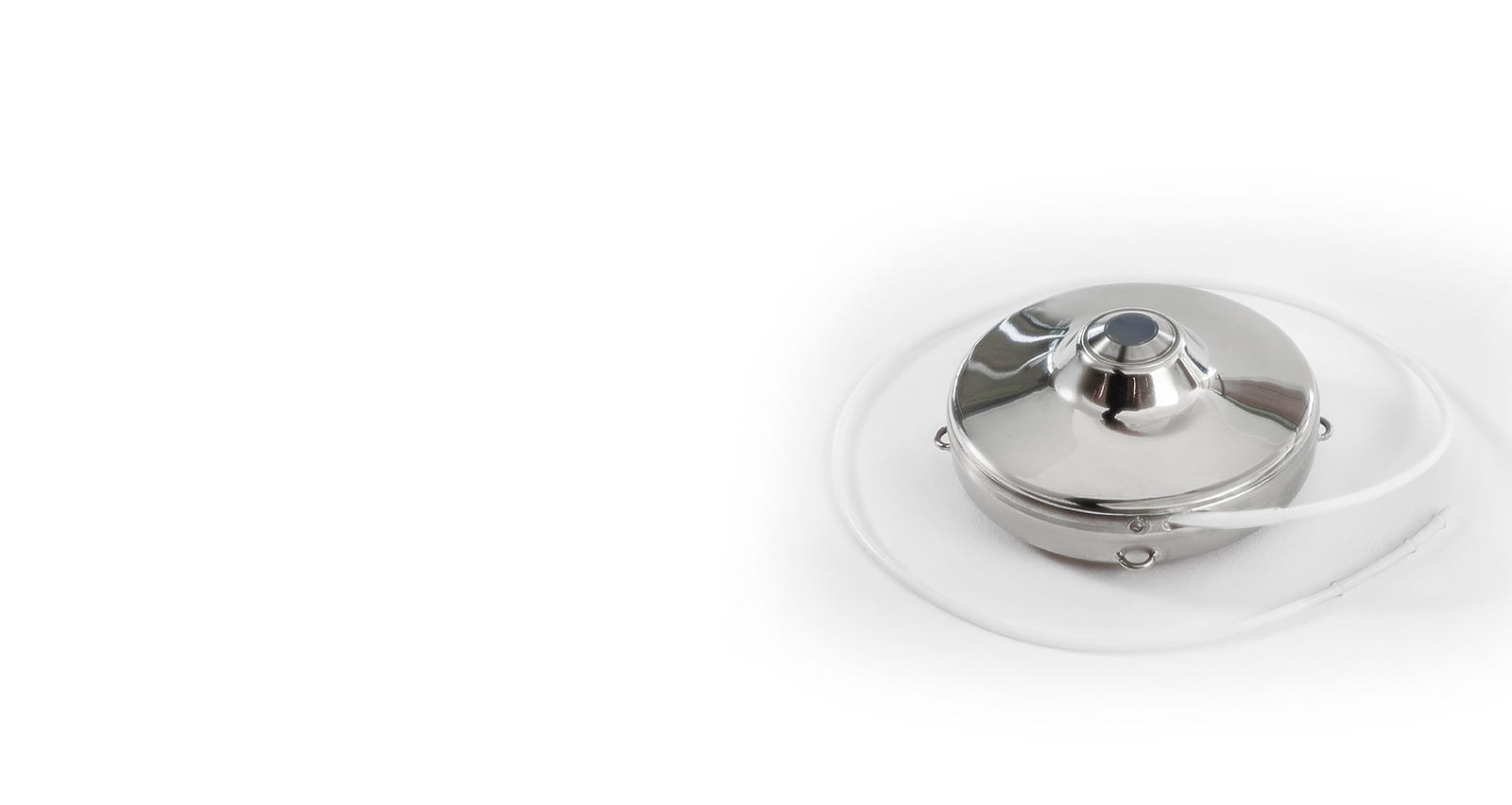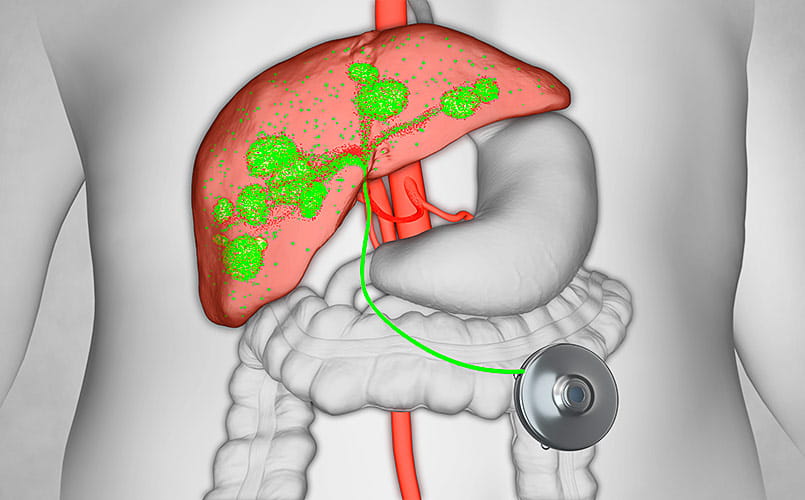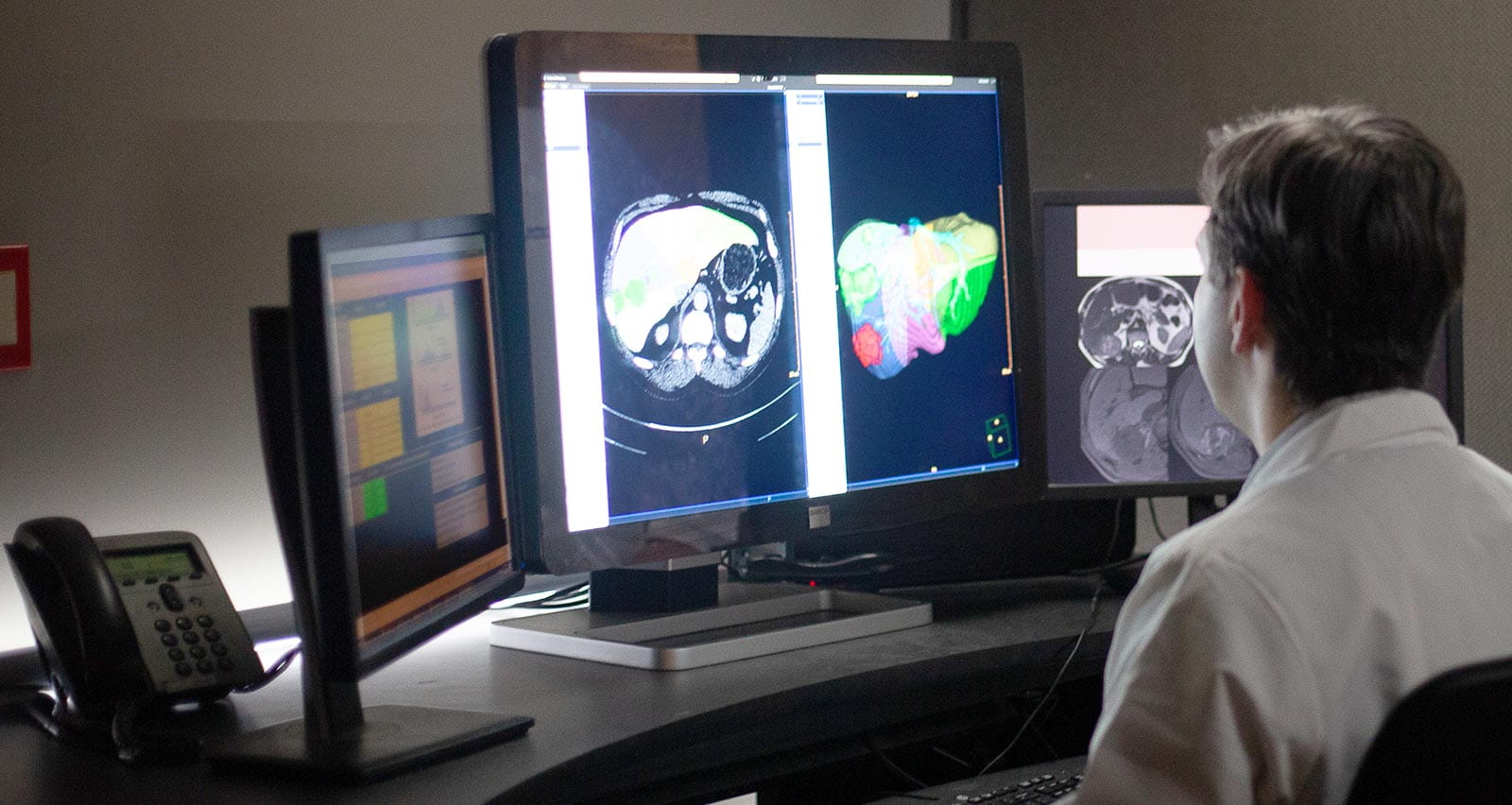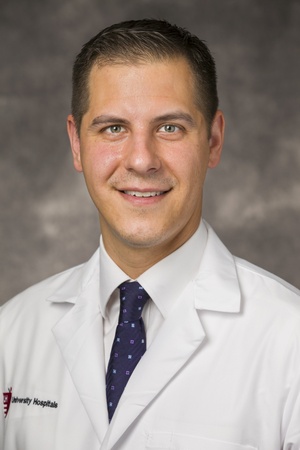
Hepatic Artery Infusion (HAI) Therapy
Hepatic artery infusion (HAI) therapy is a type of chemotherapy used to treat colorectal cancer liver metastases (colorectal cancer that has spread to the liver) and intrahepatic cholangiocarcinoma (cancer that occurs in the parts of the bile ducts that are inside the liver). HAI therapy is delivered through an implantable pump. More specifically, HAI therapy is indicated for:
- Colorectal cancer liver metastases (CRLM) that is unresectable (cannot be surgically removed).
- Treatment immediately following surgical removal of metastatic liver tumors from colorectal cancer patients to kill any cancer cells that may remain – called adjuvant therapy.
- Unresectable liver tumors arising from the bile duct (also called intrahepatic cholangiocarcinoma or intrahepatic bile duct cancer).
Call to Schedule an Appointment Today
To make an appointment, please call 216-286-3870.
Better Outcomes for Patients With Liver Metastases
HAI therapy has been in use for nearly 40 years. In that time, the therapy has shown to be effective at shrinking liver tumors in patients with unresectable CRLM and bile duct cancer, shrinking some tumors to the point where they can be surgically removed. For patients undergoing resection of CRLM (surgical removal of the tumor), HAI therapy in addition to surgery has been shown to reduce the likelihood of tumor recurrence within the liver.
Patients who receive HAI therapy always receive systemic chemotherapy to treat their tumor(s).
HAI therapy tends to be more effective the less chemotherapy the patient has had prior to getting their pump. As such, the expert cancer specialists at University Hospitals Seidman Cancer Center recommend HAI therapy as an early second-line option and even a first-line option for some patients.
Benefits of HAI Therapy
- Unlike systemic chemotherapy, in which the anti-cancer drug enters the bloodstream and circulates throughout the body, HAI uses an implanted pump that delivers chemotherapy directly to the liver. The delivery of the drug directly to the liver tumor allows for achievement of up to 400 times higher drug concentration than is possible with traditional chemotherapy. The liver rapidly metabolizes 99 percent of the drug. This precise targeting minimizes toxic side effects to the rest of the body.
- For patients with unresectable CRLM, studies have shown that HAI therapy in combination with systemic chemotherapy can increase survival to 77 months or more. In patients whose tumors shrink and undergo resection, survival can approach 10 years. The average survival of patients who receive chemotherapy alone is typically less than 36 months.
How HAI Therapy Works

In HAI therapy, a device called the Intera 3000 Hepatic Artery Infusion Pump is implanted under the skin of the abdominal wall. Small enough to fit in the palm of your hand, the pump delivers a high dose of the drug floxuridine (FUDR) directly to the arterial supply of the liver. Liver tumors live exclusively off the hepatic arterial blood supply. The non-tumor-bearing portion of the liver continues to receive blood from a separate blood vessel, the portal vein, that is unaffected by the therapy.
Patients must visit their doctor’s office every 14 days to get their pump refilled. Every other time, the pump is refilled with saline instead of floxuridine. For first-line treatment of metastasized liver tumors, treatment typically lasts for up to six months, depending on the number of tumors present, their size and how they respond to the treatment.
Once HAI therapy is complete, the pump can be filled with glycerin at intervals of six to eight weeks.
Why Choose University Hospitals for Your HAI Therapy?
Implantation of an HAI pump is a complex operation that requires a team of experts supported by the resources of a major medical center. As the first hospital in Ohio to place an FDA-approved Intera 3000 hepatic artery infusion pump in April 2022, UH Seidman Cancer Center is one of the only hospitals in the region to offer HAI therapy and is the busiest HAI pump program in Ohio.

Multidisciplinary Liver Metastases Clinic
In 2023, UH Seidman Cancer Center began offering a dedicated Multidisciplinary Colorectal Liver Metastases Clinic to provide HAI therapy and other liver-directed treatment options to patients with CRCLM.
The sooner patients with unresectable CRCLM begin HAI treatment, the better their outcomes. If you’ve been diagnosed with either colorectal cancer metastatic to the liver or intrahepatic cholangiocarcinoma, obtain a referral from your oncologist to visit our clinic so we can work together to discuss HAI therapy and other treatment options.
To make an appointment with the clinic, please call 216-286-3870.
What to Expect When You Get an HAI Pump
When you get an HAI pump, it is important to be prepared for your procedure. Preparation includes any tests you will need prior to your surgery, as well as learning what to expect about your surgery and recovery.
- Preparing for HAI Pump Implantation Surgery
-
Your surgeon’s office will provide you with information about how to prepare for your surgery, including specific instructions about when to stop eating, drinking and taking medications before your procedure. Prior to your surgery, you will have imaging done, typically a CT scan and an MRI, so that your doctor can determine where to place your HAI pump based on the pattern of your arteries.
- What Happens During the Procedure
-
HAI implantation surgery is performed under general anesthesia. Once you are asleep, your surgeon makes an incision in your upper abdomen in order to isolate the artery for the catheter insertion. Additionally, if you have a gallbladder, it will be removed, as FUDR can make the gallbladder sick. A smaller incision is made in the left lower abdomen, between your ribs and hip bone, to create a space between your skin and muscle into which the pump is then placed. A catheter connected to the pump is placed into the gastroduodenal artery.
Occasionally, in patients who are severely overweight, the pump is placed over the ribs on the left side of the body.
The implantation procedure usually takes between 1½ to 2 hours. If you’re having another procedure at the same time, such as liver tumor resection or colon resection, it may take longer. After your pump is placed, a flow scan is done to make sure the pump is working. This scan may be done while you’re at the hospital or sometime after your discharge at a follow-up visit.
- Recovery After HAI Pump Placement Surgery
-
Expect to recover in the hospital for about three days. If your pump is placed as part of as more complex operation, you will likely require a longer hospital stay.
Recovery from HAI pump placement surgery usually takes about four weeks. Once you have recovered, you should be able to resume most of your regular activities. Your surgical team will give you specific guidelines about what activities to avoid during recovery.
Once your HAI pump is placed, you might be able to see it or feel it beneath your skin. You may find wearing close-fitting clothing to be uncomfortable. As you get accustomed to the pump, you’ll be able to resume wearing tighter clothing.
- How Is the Pump Refilled?
-
Pump refilling is done at your doctor’s office. First, a nurse cleans the area of skin over your pump. Next, the nurse or your doctor inserts a needle into the pump. You may feel a mild pinprick as the needle penetrates the skin to reach the pump. The nurse or doctor will use a syringe to extract and measure any medicine or fluid left in your pump. Once the pump is empty, the nurse or doctor will refill it with either the drug floxuridine (FUDR) or saline, alternating every 14 days.
The refill process generally takes between 10 to 15 minutes. Most patients do not report discomfort during the process.
- How Long Will You Need to Have the Pump?
-
Your doctor will determine the duration of your HAI therapy and whether it will be permanently stopped at some point. Depending on your response to treatment, HAI therapy can last for months or years. Even after HAI therapy is completed, some patients do not have their pump removed. Other patients have their pumps removed in an outpatient procedure after their treatment is over with their doctor’s approval.
Physicians for HAI Therapy
John Ammori, MD
- Surgical Oncology
-
Cleveland (0 mi.)
Cleveland (0 mi.)
Westlake (18 mi.)
Richard Hoehn, MD
- Surgical Oncology
-
Avon (22 mi.)
Cleveland (0 mi.)
Westlake (18 mi.)
David Bajor, MD
- Hematology and Oncology
-
Cleveland (0 mi.)
Beachwood (7 mi.)
Melissa Lumish, MD
- Hematology and Oncology
-
Cleveland (0 mi.)
Beachwood (7 mi.)






